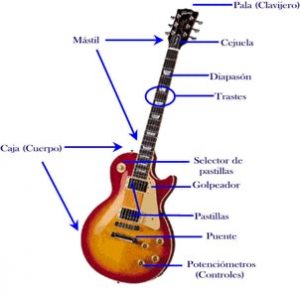An Electric Guitar, like traditional, is a plucked string musical instrument, its early history is the history of the traditional guitar and through this link we will find the specificity of the electric guitar history. Now basically we will name the parts of the electric guitar and its basic functions.

As we said at the entry of guitar history, the traditional guitar sound is amplified by a sound box but in an electric guitar, however, the sound is amplified by one or more electromagnetic pickups to convert string vibrations into electrical signals. As we also saw (in amplification) this signal must pass before through an amplifier and speaker in order to transform the electrical signal into audible sound. For this reason, the electric guitar always needs to be connected to an amplifier to be audible.
Basically, there are three types of electric guitars: solid body, semi-solid body and hollow body.
The hollow body guitars were the first to appear so they came from traditional guitars when they tried to incorporate microphones for amplification.
The electric guitar always needs to be connected to an amplifier to be audible.
This type of guitar combines the timbre of the resonance box with the sound of their electromagnetic pickups. These guitars have a wooden block inside to prevent the soundboard to vibrate and produce coupling or feedback effects. These guitars are also characteristic for their “f” or integrals as violins in its soundboard.

Solid body guitars. Usually these guitars consist of a neck glued or bolted to a piece of wood that can be a solid piece, two, three or even more. Usually this solid body has more than one piece and incorporates the circuits, pickups, potentiometers for volume and switches to switch from one pickup to another. These circuits can become quite complex and may include preamplifiers or equalizers powered by batteries.
The type of pickups and mechanisms can be found at this link guitar amplification.
The last type of electric guitars are called semi-solid or semi hollow body guitar. These guitars would be between the other two types, it is a hybrid between guitars hollow box and solid. These guitars are hollow body guitars but narrower than the full hollow.
The body of electric guitars is usually made of wood, as traditional, but it is not uncommon to find electric guitars of synthetic materials, fibers, etc…
The elements of an electric guitar are quite similar to the elements of a traditional guitar, but with some peculiarities. The bridge in classical guitars is in charge of transmitting the vibrations of the strings to the sound box to be amplified, but in electric guitar, however, this amplification is done by the pickup, so the function of the bridge on electric guitar is basically to define the string length (from bridge saddle to head nut) and set the height of each string in relation to the body.
Some bridges include piezoelectric sensors to capture the vibration of the strings and amplify the string keeping its acoustic timbre (piezoelectric sensors can be found at the link Amplification for guitar). We can find no fixed bridge with whammy bar to move the bridge and alter the sound of the notes while playing.
The body of electric guitars is usually made of wood, as traditional, but it is not uncommon to find electric guitars of synthetic materials, fibers, etc…
The neck on electric guitars may be made of one or more pieces of wood or may be made of other synthetic materials. What fundamentally distinguishes the neck of the electric guitar from the neck of classical guitars is that inside it contains a steel bar called truss rod which main function is to counteract the tension of the strings on the neck, maintain its straightness and avoid changes in the distance of the strings to the frets. In classical guitars this bar is rarely found since the tension of nylon strings or carbon is less than the produced by steel strings.
What fundamentally distinguishes the neck of the electric guitar from the neck of classical guitars is that inside it contains a steel bar called truss rod.
The head is an extension of the neck and its basic function is to hold the tuning pegs, in fact, we can find some electric guitars without head, just with pegs, although it also has a relative importance in helping us to identify the maker, brand or model of each guitar.

The main function of the pegs is to tighten or loosen the strings. As we saw, the note produced by each string depend on: the thickness of each string, the length and the tension.

Fingerboard of electric guitar is usually narrower than on classical guitars, and more often have curvature, this curvature is measured in inches, 16 “, 14″ 10”, the lower inch the lower curvature, but we can also find fingerboards with compound radius which varies the average radius as we advance through the fingerboard.
The strings are also an essential element in any guitar because its vibration is what causes the sound. On electric guitar, strings are nickel or steel because bronze and nylon do not induce the magnetic field of pickups.
Finally, to end on the electric guitar, we will talk guitar picks.

Guitar picks are a very cheap but important to determine the tone and sound of our guitar. There are many kinds of picks, of many materials and types and with multitude of thicknesses. Thickness is an important aspect in a guitar pick because it influences the tone that we will get out to our instrument. Thin picks are used for rhythms and produce finer tones, while thick picks, instead, are used for melodic solos and produce warmer tones.























